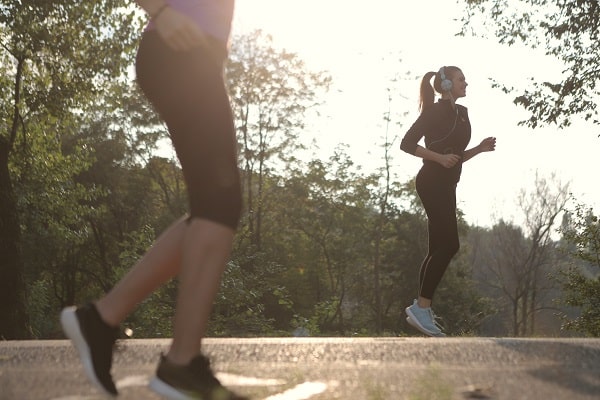As familiar as we may be with the health benefits of exercise, it’s often one of the first things we time-poor writers sacrifice in order to work on our craft. I know I do, anyway.
But in addition to the well-documented physical gains associated with a regular sweat-sesh, exercise has also been proven to increase creativity.
If you find yourself stuck in a creative rut, it might be time to swap those slippers for sneakers and pound the pavement for an hour or so.
Need more motivation? Read on for six ways exercise can get your creativity pumping along with your heart rate.
Exercise Benefit #1: Releases Neurotransmitters
We’ve all heard how exercise releases endorphins to help make us feel good, but they are just one of four mood-boosting chemicals that have a profound influence on our creativity.
Along with endorphins, oxytocin, serotonin and dopamine are the human body’s happiness chemicals. The more of these pumping around your body, the better.
A positive state of mind has been known to have a great impact on motivation, productivity and general wellbeing.
According to marketing professor Baba Shiv, the two strongest players in the creativity game are serotonin and dopamine.
These neurotransmitters are responsible for feelings of calm and excitement respectively, and while it may seem like they’re at opposite ends of the scale, they actually work together very well by creating a relaxed but energised state.
Low levels of serotonin typically cause feelings of loneliness, depression and anxiety – not the best frame of mind to be pumping out words.

While chronic sufferers of clinical depression/anxiety often require medication to keep their levels in check, there are a few natural boosters you can use to give yourself a pick-me-up.
Getting your blood pumping through a good bit of cardiovascular exercise helps stimulate the production of serotonin. You only need 15 minutes of brisk walking to feel the effects.
If you can take it outdoors for 20 and team up with a buddy or two, all the better – a sense of community, as well as good ol’ vitamin D from the sun, will also release a helpful dose of serotonin into your body.
So what about dopamine? Essentially, dopamine is your procrastinator-buster. Keeping its levels high can help you move past self-doubt and remain motivated to get things done.
It’s your ‘go’ button, and it’s self-perpetuating: dopamine makes you more focused on fulfilling your goals, and fulfilling your goals releases more dopamine. Pretty nifty, right?
Exercise Benefit #2: Grows New Brain Cells
If stimulating the production of productivity-boosting neurotransmitters isn’t enough to entice you off the couch, then how about the prospect of growing new brain cells?
And not just any brain cells – cells within the hippocampus, which plays an important role in cognitive function.
The hippocampus’ primary function is long-term memory, but recent studies have hypothesised that new cell growth in this section of the brain also enables people to imagine new ideas and situations.
Neurogenesis – the process of developing new brain cells – is something all humans have the capacity to do, even when they are naturally lost as we age.
Harvard Medical School-affiliated studies also suggest that increased production of neurons in the hippocampus can help restore key brain function.
These studies also indicated that prolonged episodes of depression actually inhibit neurogenesis in the hippocampus by up to 10%.

Considering that there is a strong connection between mental illness and creativity (more on that below), ensuring that our brain continues to operate at optimum cognitive capacity can make all the difference.
So how can we supercharge our neuron production? Aerobic exercise is the key!
Studies suggest that moderate-intensity aerobic exercise – think jogging, swimming, power-walking – yield far greater results than resistance training and HIIT (high-intensity interval training) workouts.
Plus, if you’re not a huge fan of getting too sweaty too fast (or you’ve just been out of the fitness game for a while/ever), this type of low-impact exercise is the perfect place to start.
Exercise Benefit #3: Strengthens Mental Health
Unfortunately, the ‘tortured artist’ stereotype has some alarming truth to it.
Creative types have the highest levels of depression of any group, with renowned writers such as Ernest Hemingway, Virginia Woolf and Sylvia Plath all having well-documented struggles.
So what is it about creativity that makes us more prone to mental illness? Apparently, it comes down to brain chemistry – in particular, our friends, the neurotransmitters.
A study out of Sweden discovered that perfectly healthy and highly creative individuals had similar levels of dopamine D2 receptors in their brains as those suffering from schizophrenia.
Remembering that dopamine is our motivation ‘go’ button, having more receptors means creative types are capable of divergent thoughts and making unusual and uncommon connections between ideas.
While this in no way suggests that all creative minds suffer from schizophrenia, it does highlight the link between creativity and brain chemistry – and why some people have higher levels of imagination than others.

This connection has led to an almost romanticised idea that to achieve true creative genius, one must have a degree of mental illness or instability.
Nothing could be further from the truth. Even though creativity and mental illness can be found hand-in-hand, strong mental health practices are essential to truly capitalise on productivity.
I, for one, know my word count takes a hit whenever I’m struggling through a bout of depression, and it appears I’m not alone.
Dr John Kaufman, a psychologist and creative researcher at California State University, suggests that treatment (including medication) can ‘alleviate the negative effects [of mental illness] and even allow for more fluid and creative thoughts’.
Remembering that exercise stimulates the production of neurons in the hippocampus and the release of the mood-regulating neurotransmitter serotonin, incorporating a daily jog or brisk walk could be just what the creativity doctor ordered.
Exercise Benefit #4: Establishes Routine
Routine can be a touchy subject for creatives, with some finding freedom in the familiar and others becoming trapped by predictability.
While we support the importance of a writing routine around here, we understand that establishing healthy and creative habits is about so much more than time spent hunched over a laptop.
Including a burst of exercise into your daily routine not only improves your overall health, but can also be key in unlocking your full creative potential, especially when you consider the timing of your workouts.
For many people, mornings are undoubtedly the best time. Choosing to get your exercise over and done with first thing in the morning is great if it’s not something you particularly enjoy.
Having completed your sweat-sesh before sitting down to write will help your concentration, as you won’t have a later obligation hanging over you, stealing your focus.
More importantly, writing straight after a morning workout helps you make the most of your already elevated serotonin levels by stimulating the production of even more neurotransmitters.
As the brain restores its serotonin cache during REM-sleep, getting on with a quick workout soon after waking keeps your creativity pumping for longer.

Want to fine-tune that routine even more? Combine your morning workout with a high-protein breakfast and a caffeine jolt to amplify the effects.
Remember, it only takes 15 minutes of cardio to release serotonin, so a brisk walk around the block is all you need to start your day with maximum brain power.
Daily exercise is a common component of many professional writers’ lives – perhaps none more famously than Japanese author Haruki Murakami, who dedicated an entire memoir to the joys and benefits of running.
While Murakami does not solely rely on running to generate his creative ideas, the recurring habit of freeing his mind through exercise has certainly left the doors open for inspiration.
“I try not to think about anything special while running. As a matter of fact, I usually run with my mind empty.
However, when I run empty-minded, something naturally and abruptly crawls in sometime. That might become an idea that can help me with my writing.”
— Haruki Murakami, 2005
You certainly don’t need to dedicate yourself to daily 10 km treks like Murakami; however, setting aside some time to keep your mind empty and body moving definitely has its benefits.
Exercise Benefit #5: Change of Environment
A change is as good as a holiday, right? And for writers who primarily work at home, the importance of a change of scenery can’t be overstated.
If you’ve been spending hours upon hours at your desk, it’s little wonder that your creativity (along with your mental health) might start to take a downward turn.
Heading out for exercise is something any struggling writer should take advantage of. Getting out in nature has long been known to have significant benefits on our physical and mental wellbeing.
Recent studies have also unearthed the impacts fresh air and greenery have on one’s creativity. A 2012 study into the connection between nature and cognitive function discovered that four days spent outdoors increased participants’ creative abilities by up to 50%.
But you don’t need to head off on a week-long camping expedition to reap the benefits. A 25-minute walk through a ‘green space’ is all you need to give your brain a rest and boost its cognitive and creative function.
Nature also has a fantastic way of inspiring writers, and coupling the therapeutic benefits of greenery with the neurotransmitters released through exercise is a great way to get those creative juices flowing again.

The great outdoors has the ability to boost mental health, too, so if you’re feeling down thanks to a creativity block, going for a stroll outside might be a better option than your usual indoor weight session.
But not all breaks away from the computer are created equally. If you’re hoping to cash in on your change of scenery recharge by heading to the shops, think again.
Studies undertaken by mental health organisation MIND discovered that 22% of participants actually felt worse after walking around a shopping mall, as opposed to the 77% who noticed improvement in their depression after taking a nature walk.
While you’ll still get the neurochemical benefits of walking around, remember to consider the role mental health plays in creativity as well. The last thing you want to do is take one step forward and two steps back.
Exercise Benefit #6: Conquer Writer’s Block
Ah, a cure for writer’s block – the Holy Grail for suffering wordsmiths the world over.
Writer’s block tends to strike when inspiration is low, or when you’re having problems with a story – such as struggling with a plot hole or feeling confused about a character’s motivation.
With many writers turning to different projects or creative writing prompts in an attempt to move beyond their block, physical exercises instead of written ones may just be the key.
Running is one of the most recommended activities. Murakami isn’t the only famous writer to have tapped into this unexpected vein of creativity.
American author Louisa May Alcott and philosopher Henry David Thoreau both attribute running to a boost in the creative process, with the latter going as far as to say ‘the moment my legs begin to move my thoughts begin to flow.’
Part of the reason exercise can help unleash the creativity required to push past a writer’s block is the way it can quieten the activity in the prefrontal cortex – the part of the brain responsible for complex actions such as cognitive behaviour, decision-making and expression of personality.
This calming of the prefrontal cortex happens when we’re engaged in non-mentally-taxing activities, such as a walk in the fresh air, and allows our brain to revert to a default setting: a network of imagination not distracted by other cognitive tasks.
By allowing this freedom to take over, our minds can idle and wander into deeper emotions, memories and ideas.

When the Imagination Network is engaged, we’re also better able to understand social interactions, such as speculating what another person is thinking or how they may react – which can be highly useful if character problems are contributing to your current block.
However integral, imagination is not the thing that will save you from writer’s block. You may also need an extra helping of problem-solving skills to nut out that pesky plot hole.
Not only does exercise help create neurons in the hippocampus to improve our memory (great if you’re struggling to recall how you previously mitigated plot woes), it can also increase our ability to problem-solve by up to 20%.
So, if other creative exercises or writing prompts aren’t giving you the solutions you need to conquer your writer’s block, perhaps it’s time to boost your brain’s cognitive and imaginative functions through some good old-fashioned blood-pumping.
***
The brain is a powerful tool, and ensuring that it’s functioning in tip-top shape can make all the difference when it comes to creativity.
Whether your brain needs a rest and a chance to daydream, or an injection of creativity-enhancing neurotransmitters, exercise is one sure-fire way to keep your mind in peak condition.
If you’re not into regulated team sports or sweating it out at the gym, incorporating something as simple as a daily walk outside could be all you need to keep your mind and body fit.
Does exercise help you stay creative or work through writer’s block? We’d love to hear your tips in the comments below!